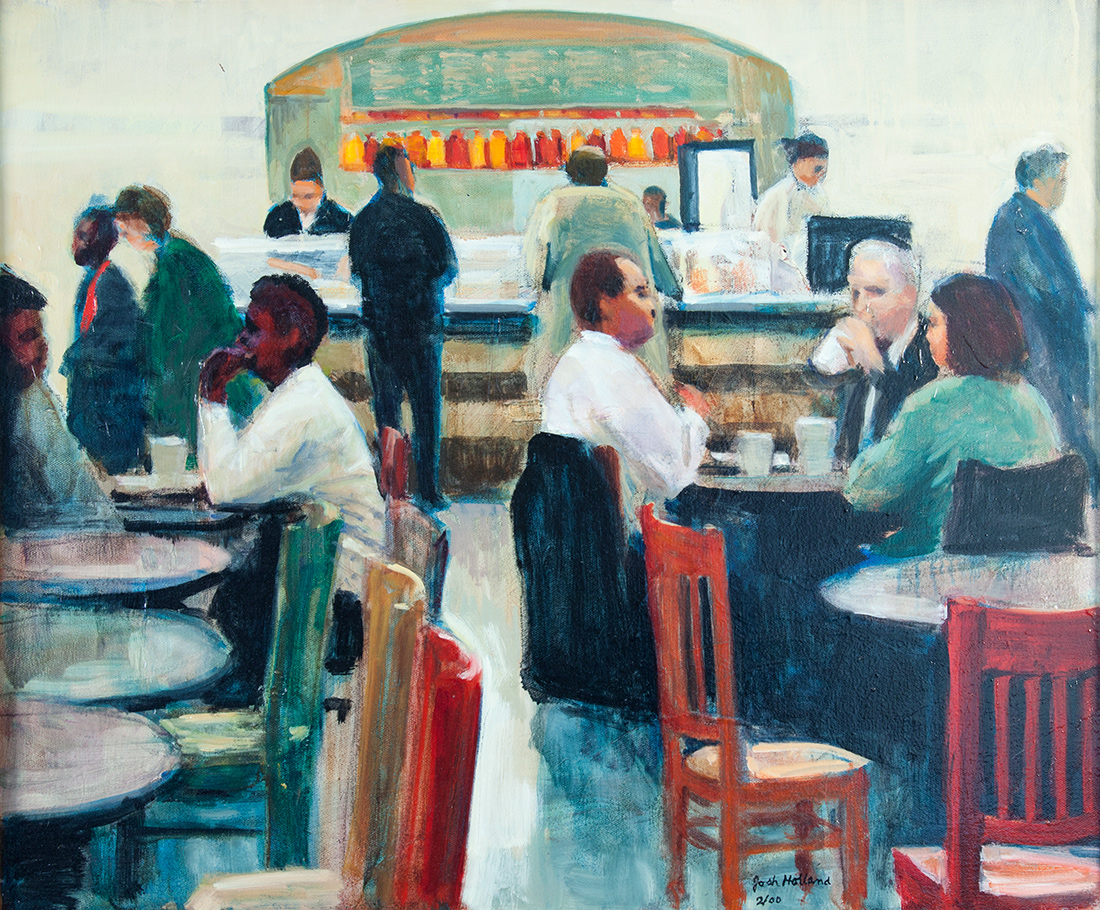
Josh Holland, born 1921 in Chicago to immigrants fleeing religious oppression in Russia, studied at the Art Institute in Chicago in the years before and after World War II, having earned a degree in math by the age of 16, and science shortly therafter from the University of Chicago. Following a seminal 33 year career in meteorology, Josh Holland returned to art as a primary focus in 1981. During the 1990’s, after a period of working alone on landscapes and portraits, he was reintroduced to the joy of creating compositions of human figures, regularly working from models with a group of painters in the Chevy Chase, MD “Somerset Studio” of the late Leo Saal. During the same period, occupying a loft on the second floor of the Studio Theater at 14th and P Streets in NW Washington, DC, he did many paintings and drawings of the pedestrians along 14th Street. Subsequently his efforts to collect images of people, with sketchbook and camera, took him to Union Station, Dupont Circle and to shopping mall food courts. This theme continued to fascinate him.
Guided in the selection of subjects by a love of people and a sense of wonderment at their diversity and beauty, as well as the signals of inner life from gesture, attire, expression and relationships, he stated his objective “to make pictures that are arresting at first glance and rewarding to look at over time.” The potential power of composition, whether in an abstract or representational work, was impressed on him by seeing the paintings of Richard Diebenkorn, as well as those of many masters from Titian and Vermeer to Cezanne, Picasso and Helen Frankenthaler. He was inspired in his early years by his distant cousins Raphael and Moses Soyer, deeply impressed by their expressive realism and visual depictions of unspoken social connections and alienation, as well as the model that art making could be a career choice.
He produced a constant stream of paintings throughout the last three decades of his life from studios in Washington, DC and Maryland: sunsets, scenes in College Park and Takoma Park, Maryland , self portraits and portraits of others, the Pedestrian Series, his “Heroes” series of sketches and prints of Mandela, Havel, and Sakharov; studies of people interacting in food courts, Union Station, Dupont Circle, and annual summer sketches of ocean and beach scenes. He often submitted work for juried review and participated in the local Foundry Gallery, as well as showing around town in galleries, at Art at Strathmore, and in municipal buildings in Takoma Park. He took a painting studio class at the Studio School in January 2011, at the age of 89, in order to work once again in the company of other artists, as his 2nd wife’s long-term illness had been quite isolating. He painted right up until his death in May, 2011, a month before his 90th birthday.
Oil on canvas and watercolor on paper were his primary media, though he played with printmaking, woodcuts, lithographs, and kept a continuous sketchbook of ink and charcoal drawings. He also enjoyed taking photographs, using photography to provide materials for several commissioned portraits, and for the Pedestrians and Heroes series, finding the digital technology quite liberating. His sketchbooks throughout his 75 years of art making recorded the world around him, the people in his life and his ideas about approaching figure in space.
He was known, and published, in the field of meteorology as Dr. Joshua Z. Holland. Involved with studies of atmospheric transferance of materials, he participated in fallout studies in Los Alamos relating to the newly emerging atomic energy field. His intense interest in the boundary layer between atmosphere and ocean took him into global scientific experiments in Barbados and Dakar, collaborating with scientists from all over the world often in the role of chief scientist on behalf of the National Oceanographic and Atmospheric Administration. He saw the evolution of this entire field of study, yet even as a young officer, predicting the weather for bombing raids in World War II, he sketched cloud structures in Guam and made portraits of his fellow officers. He married Anabel Schreiber in 1947, a fellow artist from the Art Institute in Chicago, with whom he raised three children. Divorced in 1983, he married Sandra Handverker the following year, living within the Maryland-DC Metropolitan area for the majority of his adult life. His works are held in many private collections. Many are owned by the District of Columbia Commission on the Arts and Humanities, displayed in many public buildings and on their Art Bank website (23 paintings), and images of 6 of his photographs are visible using the “Beauty” link of the Friends of Sligo Creek.



